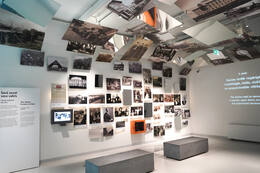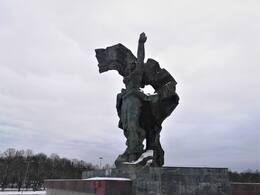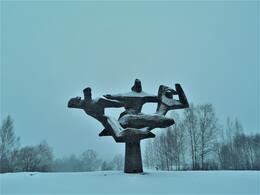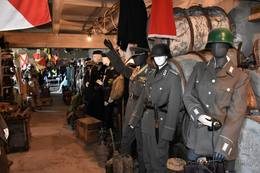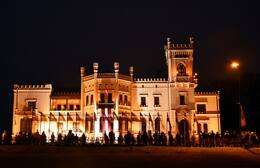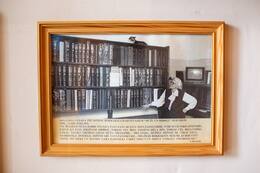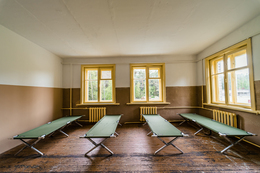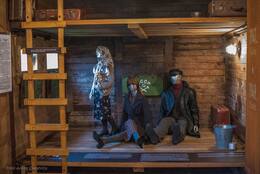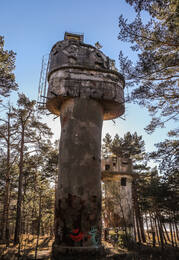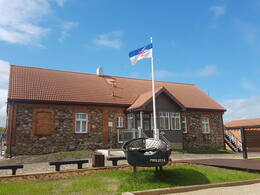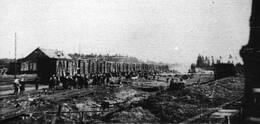Totalitarianism
II World War II, IV Soviet Occupation
Totalitarianism (from Latin totalis 'all-encompassing'; English Totalitarianism, German Totalitarismus, French totalitarisme, Russian тоталитаризм) - a political system in which the state is governed without public participation, decisions in totalitarianism are made without coordination with the majority of society; the most important social, economic and political activities in a totalitarian regime are controlled by the state. This is a type of dictatorship in which power limits a person in all spheres. Under conditions of dictatorship, power belongs to a small circle of people or even one person. Characteristic features: state power is concentrated in the hands of a narrow group - a clique; suppression of the opposition, general terror as an instrument of state administration, subordination of all spheres of life to the interests of the state and the dominant ideology; permanently mobilized society, using the cult of leadership, mass movements, propaganda, etc.; aggressive, expansion-oriented foreign policy; complete control over public life.
The period of totalitarian regimes in Latvia is chronologically divided into 3 stages: 1) the first occupation by the USSR from June 17, 1940 to July 1941; 2) the occupation by Nazi Germany from July 1941 to the fall of 1944 (in Courland until May 1945); 3) the period of the second Soviet occupation from the fall of 1944 to the death of Stalin in 1953.
The term totalitarianism was coined by the Italian anti-fascist publicist Giovanni Amendola. In 1925, the term was adopted by the Italian Prime Minister and dictator Benito Mussolini, and the fascists began to use it as a term for their political system. From the Italian fascists, the idea of “totalitarianism” was adopted by German right-wing intellectuals, such as the philosopher Carl Schmitt, a critic of liberalism and the liberal state.
There is debate in academia about which regimes can be considered totalitarian. There is a general consensus that the 20th-century regimes in Nazi Germany (1934–1945), the USSR under J. Stalin (1929–1953), China under Mao Zedong (1949–1976), the Democratic People's Republic of Korea (North Korea) under the Kim dynasty (1948–present), and the Pol Pot regime in Cambodia (1976–1979) are considered totalitarian. Opinions differ about other countries or other periods of time in the countries mentioned.
More information sources
Daina Bleiere. Totalitarianism. National Encyclopedia. https://enciklopedija.lv/skirklis/51186
Totalitarianism. Wikipedia. https://lv.wikipedia.org/wiki/Totalit%C4%81risms
Related timeline
Related objects
Museum of the Occupation of Latvia
The museum exhibits the history of Latvia from 1940 to 1991, under the occupation of Nazi Germany and the Soviet Union. ‘House of the Future’ is a reconstruction and expansion project of the Occupation Museum designed by the well-known American Latvian architect Gunārs Birkerts as well as the new exhibit of the museum. The exhibit ‘History of Cheka in Latvia’ was created by the Occupation Museum and it is located in the ‘Corner House’, which is the former USSR State Security Committee (KGB) building. Latvian Occupation Museum was founded in 1993. It tells the long-hidden story of the fate of the Latvian state, nation and land under the occupation of two foreign totalitarian powers from 1940 to 1991. At the end of 2020 the museum had more than 70,000 different historical items (documents, photographs, written, oral and material evidence, objects and memorabilia). Museum specialists have recorded more than 2,400 video testimonials, making it one of the largest collections on occupation in Europe. The events that unfolded in Latvia, Lithuania and Estonia clearly show us what the nations had to endure under the two totalitarian regimes.
Victory Park
Located in Riga, Pārdaugava, near the National Library of Latvia.
Victory Park is one of the largest and most controversial parks in Latvia. It occupies 36.7 hectares of territory, where a monumental ensemble “To the Liberators of Soviet Latvia and Riga from the German Fascist Invaders” glorifying the Soviet occupation power has been created. Built on the site of 17th century fortifications, it was the last known place of public execution in Latvia.
At the beginning of the 20th century, a landscape park was created on the territory of the former Kobrona fortress. It is dedicated to the Russian Emperor Peter I, whose army captured Riga in 1710. After the establishment of the State of Latvia, an ambitious project was planned for the territory - Victory Park. It was intended as a place of honoring the heroes of the War of Independence, a symbol of the greatness and self-confidence of the Latvian state. The park, built with public donations, was intended for major events, but World War II interrupted the plan.
During the Soviet occupation, the park area became the execution site for 7 German army officers. This was a significant event for the opening in 1985 of the largest object glorifying the Soviet regime and its army in the Baltic States.
Until 23.08.2022. (dismantled) you could see the monumental ensemble, which represented the prevailing trends in monument construction in the Soviet Union. The spacious park area is perfect for walks and active recreation.
Monument for the Freedom-Fighters
Located in Tukums, Mālkalns, Jelgavas Street 15A.
The monument was unveiled in 1975 to highlight the merits of the Red Army during World War II. It served as a means of Soviet ideology and propaganda, symbolically strengthening the presence of the occupation regime in Latvia and creating the myth of the Soviet regime as “liberators”. The author of the monument is sculptor and Tukums native Arta Dumpe.
After the capitulation of Germany on May 8, 1945, the Red Army perceived Kurzeme as a territory conquered by the enemy, not a liberated part of the USSR. The inhabitants of Kurzeme were enemies and their property was considered trophies of war. The repressive authorities and the army began the “cleansing of Kurzeme”. Men aged 16 to 60 were detained, registered and checked. In terms of danger, the inhabitants of Kurzeme – men – were equated with the military personnel of the capitulated Germany. The Red Army’s permissiveness and a wave of crimes began – murders, rapes, robberies, arrests and “disappearances of people”. The only armed resistance came from the National Partisan groups. The Soviet authorities created destroyer battalions, including in the Tukums district, to eliminate any opposition. The wave of violence and terror reached its peak in 1949, when deportations of the population took place throughout Latvia.
The monument can be seen today. Its symbolic meaning has been interpreted in various ways - a battle scene or a mother holding her sons fighting on opposite sides. The monument is set on a hill, from which a spectacular view opens.
Private military collection in Mundigciems
Private military collection in Mundigciems. Aivars Ormanis has been collecting historical objects for many years - military uniforms, uniforms, camouflage, communication devices, household items, protective equipment from different periods and countries, dating back to the Second World War, the Soviet army and the restoration of independent Latvia.
The collection is currently not well maintained and the exhibits are housed in a former collective farm barn.
Alūksne Museum
The Alūksne Museum is located in an architectural monument of national significance: the neo-Gothic Alūksne New Castle built in the late 19th century. The museum features an exhibition named ‘Memorial Room for Victims of the Totalitarian Regime’, which tells about the fate of the inhabitants of Alūksne municipality in Siberia and the Far East, while the time periods from prehistory to the present meet in the Alūksne history exhibit ‘Feast of the Ages’. It features a separate section devoted to the contribution of the 7th Sigulda Infantry Regiment to the military, culture and public life. The formation of the 7th Sigulda Infantry Regiment began on 20 June 1919 in the Naukšēni Manor. Initially, a battle group of 22 officers and 1,580 soldiers was formed from the reserve battalion of the Northern Latvian Brigade, and was named the Dankers Division. It was included in the 2nd Battalion of the 3rd Jelgava Regiment. On 23 August, following an increase in the number of companies, it became part of the 7th Sigulda Infantry Regiment. Having taken part in the battles against Bermondt, on 5 January 1920, the regiment was transferred to the Latgale front to fight the Bolsheviks. After the signing of the Peace Treaty with Soviet Russia, the regiment guarded Latvia’s eastern border. The Latvian War of Independence saw the deaths of more than 200 soldiers of the regiment, while 85 were awarded the Lāčplēsis War Order. In 1921, the 7th Sigulda Infantry Regiment was stationed in Alūksne. The regiment’s headquarters were set up in the Alūksne New Castle. After World War II, the castle was taken over by Soviet security institutions. As of the late 1950s, the castle housed various cultural institutions: the Culture and Cinematography Department of the Executive Committee, a pioneer house, a library, a cinema and a museum.
Museum of Melānija Vanaga and Siberian dugout
The Melānija Vanaga Museum is located in the Amata village school in Cēsis municipality. The museum showcases materials about the life, literary activity, family and destiny of writer and cultural historian Melānija Vanaga: video content about Siberia and the deported Latvians living there and a Siberian dugout taking its visitors on a trip to the writer’s place of deportation in Tyukhtetsky district, Krasnoyarsk region. The appearance and layout of the dugout form a realistic idea of life away from home. The dugout features unique historical objects brought there from the Tyukhtet Museum: a birch-bark dish known as ‘tuyesok’, a clay mug known as ‘krynka’ and a kerosene lamp. The museum features video interviews with politically repressed people from the municipality and 18 characters from Melānija Vanaga’s book Suddenly, a Criminal: Sixteen Years in Siberia. The museum’s virtual exhibition ‘BE YOURSELF!’ (http://esipats.lv) shows the experiences of five deported children and their parents who were wrongly accused by the Soviet authorities of ‘betrayal of the motherland’.
Soviet army military base in Pāvilosta - active recreation centre
During the Soviet era, a border guard unit was located here, other Soviet army units - liaison officers and a surface-to-air missile base were located several kilometres away in the forest. After independence, the Latvian army was stationed there.
The former Soviet army military base is now a recreation, leisure and camping centre - for personal development in interaction with nature and the people around.
A place for recreation and accommodation for both tourist groups and families. Rooms, showers, WC, fireplaces, spacious area for activities, sounds of nature. Book in advance by calling +371 26314505.
Cattle wagon used for deportations – museum at Skrunda train station
To commemorate the deportations of June 1941 and March 1949, a memorial stone and a four-axle wagon, which also serves as the museum dedicated to deportations, was erected at the Skrunda railway station. This is the first wagon-type museum in Latvia that holds a permanent exhibit of photos, letters, memoirs, documents and various items made by the people deported from the Skrunda station. Skrunda station was a location where deportees were gathered, and one of the three stations in the region to which people from the Skrunda and the Kuldīga area were brought. In 1941, the family of the first President of the restored Republic of Latvia, Guntis Ulmanis, was deported from here to Krasnoyarsk Krai in Siberia.
With the help of deportations, the Soviets dealt with supporters of the national partizans’ and at the same time intimidated the remaining rural population, forcing them to join the collective farms.
Karosta, the Military port of Liepāja (tour)
The Karosta is the largest historical military territory in the Baltics and occupies almost one third of the entire territory of Liepāja. The Karosta is a unique compound of military and fortification buildings on the shores of the Baltic Sea with a special meaning in the history and architecture of Latvia and the world. The Karosta features such military heritage sites as the North Pier and forts, the Redan, Karosta Prison, Karosta Water Tower, St. Nicholas Orthodox Maritime Cathedral, Oskars Kalpaks Bridge and others.
Pāvilosta local history museum exposition
Named ‘Pāvilosta, a Closed Area’, the exhibit in the Pāvilosta Local History Museum is about everyday life in the town of Pāvilosta during the Soviet occupation; specifically, about the executive branch, border area, fishermen’s collective farm, and the cultural and social activities. In addition to the permanent exhibit, there is an interactive and emotionally rich digital exhibit in two languages and an audio-visual installation offering a film about Pāvilosta.
The museum also features a new exhibit named ‘The Golden Sand Grains of Pāvilosta’. The digital installation showcases old events, how Pāvilosta was founded and the most important developments from 1918 to the present day. Military heritage is a point of focus in the War of Independence section, which tells a story about the freedom fighters of Latvia and the time of the Soviet occupation.
Stende railway station in narrow gauge railway network and the memorial stone for deportations
The railway line Ventspils - Mazirbe, as well as the Stende - Dundaga extension to Mazirbe with a branch to Pitrags, were intended only for strategic military needs. During the construction of these lines, and afterwards, all civilians were evacuated from the region. The main task of the military railways in the Irbe Strait area was to provide the German army's coastal defence positions with guns and ammunition.
These military-only military railways also connected the three most important lighthouses, located in Oviši, Mikeltornis and Šlītere.
Nevertheless, passenger transport was also provided as early as the years of World War I.
A memorial stone (1989) to the deported Latvians of 1941 and 1949 is located at the Stende railway station.
On 30 October 1919, Stende railway station was occupied by Bermont troops. On 17 November, soldiers of the Latvian army led by K. Šnēbergs attacked the station, driving away a wagon with weapons, war materials and grain. 6 soldiers were awarded the Order of the Order for these battles: K. Bumovskis (1891-1976), P. Strautiņš (1883-1969), R. Plotnieks (1891-1965), E. Jansons (1894-1977).
Related stories
The deportation train secretly photographed near Skrunda Station in 1949
On 25 March 1949, Elmārs Heniņš, a pupil in Skrunda, witnessed his classmates being taken away. He took his camera and climbed a pine tree on a nearby hill to document what was happening, later hiding the pictures.
Kolka Coast Guard Observation Tower
Hidden in the last pine trees of Cape Kolka is a border guard tower, where a border guard post was constantly located during the Soviet era, and the small stone building next to it is now abandoned and falling into ruin.
The Battle of Dzelzkalni in the Zūri Forest on February 23, 1946
The winter of 1945/46, the Brass Group spent in the Zūri forest in the Dzelzkalni area, where several bunkers had been built. Approximately 40 partisans lived there. On February 23, 1946, the camp was surrounded by the USSR Internal Affairs troops and a fierce battle took place.
The capture of Kabyle at the turn of 1945-1946
One of the most striking manifestations of post-war armed resistance in Kurzeme was the capture of Kabile on Christmas 1945 and the subsequent battle near the Āpuznieki house on January 1, 1946.
Pēteris Čevers - national partisan and commander of a partisan group
Pēteris Čevera - national partisan and commander of a national partisan group
The role of former legion lieutenant - Cheka agent Arvīds Gailītis in the liquidation of the Pēteris Čevers group
Captain Pēteris Čevers and seven other partisans were captured on November 1, 1950, in the Engure forest massif, where, quite by chance, a fake partisan group led by former Legion Lieutenant Arvīds Gailītis (the agent-combatant's nickname "Grosbergs") was stationed nearby. It included operatives of the Latvian SSR VDM and agent-combatants who posed as "forest brothers".
US CIA paratrooper Leonids Zariņš - "unfit for recruitment" by the Cheka
Leonid Zariņš was recruited as a CIA agent in the USA and in 1953 he crossed the USSR border on a plane from Germany and parachuted near Auce. Unfortunately, one of the contacts he was supposed to contact had turned out to be a double agent, and Leonid was soon arrested. He refused to cooperate with the Chekists and was shot without trial in 1954.






